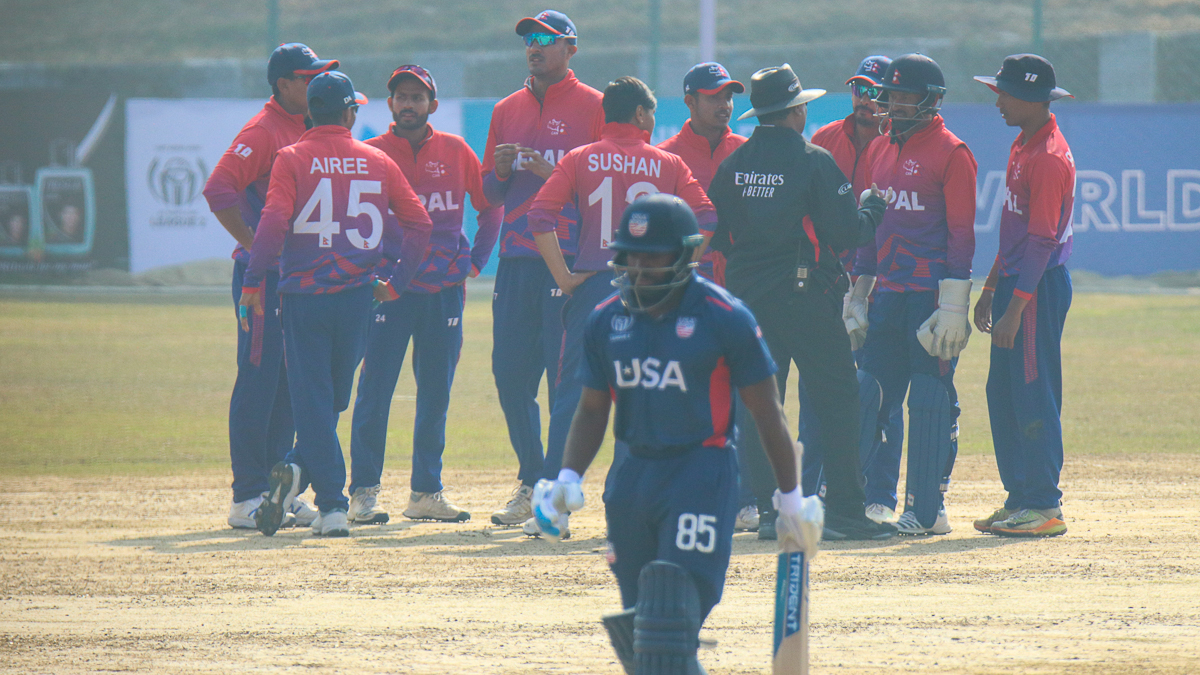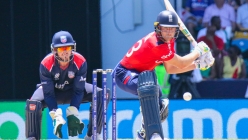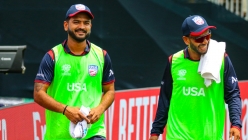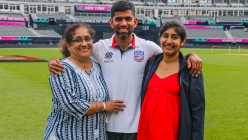Views
USA Cricket: 2020 CWC League 2 Nepal ODI tri-series Tour Report Card Part 1 – Team Grades
2020 Feb 17 by DreamCricket USA

By Peter Della Penna (Twitter @PeterDellaPenna)Photo credit: Peter Della Penna
The analysis of one of USA's worst ever tours in their limited overs history begins with an in-depth breakdown of USA's collective grades in group disciplines: batting, bowling, fielding, fitness and tactics.
Batting: F
Once again, USA’s batting was exposed for their overall frailties, but especially against spin. Of the 40 wickets lost by USA in the series, 14 came against pace and 25 against spin, the other courtesy of a runout. It was all the more lamentable considering that USA had specifically undertaken a prep tour to Mumbai in order to focus on adapting to spin, but if anything that mission seemed to dent their confidence rather than provide any level of acclimatization or comfort leading into the first ODI.
USA only produced three 50-plus scores during the series, two of them by Ian Holland and one by Nisarg Patel. More alarmingly was the series of low scores USA had throughout the tour. Out of their 40 dismissals, 27 of them were achieved by batsman who could not make it past 10 runs. It wasn’t that batsmen were getting starts but failing to kick on. They couldn’t get a start period.
That also contributed to USA’s dismal ability to get a partnership going. USA only had two 50-plus stands during the entire series: an 82-run stand between Holland and Akshay Homraj against Oman, and a 70-run stand between Nisarg and Aaron Jones in the rematch against Oman. By comparison, Nepal had three 50-plus stands (and were mathematically denied the ability to get more than that because their target against USA was 36 on the last day) while Oman had six stands of 50 or more runs including two massive century stands.
It was an all-round horror show for USA whose batsmen made the wickets look far more difficult to bat on than they actually were. In reality, poor techniques were badly exposed. The constant problem against spinners was a default first step onto the back foot when many of the wickets that fell to spin were to fuller length balls in which batsmen really should have been on the front foot. It resulted in an overwhelming number of bowled and lbw dismissals. USA’s collective refusal to use their feet to come down the wicket exacerbated the issue. Barring Holland, few batsmen showed any level of comfort attempting to sweep either.
These are technical areas that USA’s batting unit has failed to develop over the years but were ruthlessly exposed against teams with quality spin arsenals at Associate level. Until the technical approach is rectified, USA will always struggle in similar conditions and against similar attacks.
Bowling: D
A very hard grade to determine mainly because it was affected by the generally poor, bordering on awful, tactical rotation of bowlers. The bowlers that USA used generally performed okay, not great, in most situations. But other possibly better options failed to be utilized. More of that will be discussed in the tactics section.
USA’s medium pacers took 18 wickets and their spinners just four during the four ODIs. It was a consequence again of USA’s tactics and team selection being heavily imbalanced. USA only bowled 37 overs of spin in the first three ODIs, and the final match only had a chase which lasted 5.2 overs.
Despite coach James Pamment and captain Saurabh Netravalkar claiming that they were “sticking with their strength” by bowling an excessive amount of pace (111.5 overs to be precise in just three matches, meaning an average of 37+ overs of pace bowled per match), it hardly paid true dividends. Oman’s pace bowlers also took 18 wickets, but did it in 90 overs spread across four matches. Simply put, Oman’s pacers bowled more efficiently to take wickets at a much better strike rate before handing over to the spinners. USA continued to bowl pace regardless of how effective or ineffective it was.
In spite of being in the field for essentially three matches instead of four, USA conceded the most number of 50-plus partnerships of the three teams during the week. There were five as a whole, including a 216-run partnership by Oman. USA also conceded the most number of individual 50-plus scores by players during the week in spite of the same ignominious feat on the final day against Nepal which mathematically denied any Nepal player from adding to that list. There were six 50-plus scores by opposition batsmen, including two centuries.
Fielding: D
Once again, in spite of the fact that USA spent just 154.1 overs in the field, they committed far more gaffes that allowed opponents off the hook. USA failed to convert at least ten chances in the field, six chances in the air and four runout chances, that cost then a total of 188 runs. On a week when they could ill afford to give away extra runs due to their fragile batting, this was especially costly. By comparison, USA’s opponents only missed three chances in the field for a total of 26 runs. It meant USA was a staggering minus-162 in terms of the amount of runs in arrears to the opposition. An average of 26.86 runs were scored after the initial missed chance, if a batsman was dismissed at all.
The costliest miss came in the first match when Oman’s Aqib Ilyas was on 1 and 2 on back-to-back deliveries bowled by Rusty Theron that were pulled to Xavier Marshall at deep fine leg. Marshall was unable to read the first one well enough off the bat to come forward quickly enough, eventually getting one hand to it but could not hold on. The next ball, Marshall again reacted poorly, this time coming in when he should have gone back only for a chance to land a yard over the rope for six. Had he gone back or not been cheating in off of what was already a short boundary, it would have been a clear catching chance. Ilyas made 72 after the pair of lives.
A series of lives in the first match against Nepal were also very costly not as much for the runs that were taken after – a total of 27 in what was a 35-run loss – but for the time that it allowed Nepal to extend their innings. Kushal Malla was on 38 when he was dropped on the easiest chance of the series at mid-off by Monank Patel off the bowling of Theron. It came in the 32nd over and would have been the sixth wicket at 115 for 5. Similarly, Sushan Bhari was dropped at point by Karima Gore on 5 in the 43rd over with the score at 164 for 8, but instead was able to hold up an end until the final over. Binod Bhandari was dropped on 50 by Netravalkar running across from mid-off after failing to react initially to a skier in the ring off Hutchinson. Again, this was in the 45th over for what could have been the ninth wicket at 172 for 8. Instead, Bhandari was able to shield the tail until the 48th when he lost his wicket charging Theron. Nepal realistically could have been bowled out inside of 45 overs, perhaps even 40 overs, had those chances been held, resulted in a naturally lower score that would have been easier to chase and severely impacted the final result.
Perhaps one of the few bright spots in the field was the one-handed catch that Nosthush Kenjige took as a sub fielder in USA’s second ODI against Nepal. But again, those brilliant moments were too few and far between on tour. USA’s ability to hit the stumps was poor. They were the only team not to complete a runout despite a handful of clear chances. Arguably the biggest miss was when Akshay Homraj botched a collection of a relay from Cameron Stevenson when Zeeshan Maqsood was on 61 before going on to make 109 in the third of USA’s four ODIs. The fielding issues are especially disappointing considering that fielding is James Pamment’s specialty and he had a very positive influence in raising USA’s collective fielding standards in recent months before they fell away badly in Nepal.
Fitness: B-
There were few if any noticeable injury issues on tour outside of the regular slight nicks that would send a player off periodically for treatment. The temperatures in Kathmandu were consistently between 50 and 60 degrees Fahrenheit, again not the type that would test anyone’s endurance by any stretch of the imagination. USA’s issues were technical, mental and tactical. Speaking of which…
Tactics: F
This arguably started with team selection before getting on the plane for the warm-up matches in Mumbai. Regardless of how well Elmore Hutchinson did in the warm-up matches in Mumbai by finishing as the team’s leading scorer and wicket-taker prior to landing in Nepal, that says more about the failures of everyone else, especially on the batting and spin bowling front. Nepal historically has had spin friendly conditions. If Hutchinson did not get a game all tour in the UAE on wickets that were slightly more favorable to pace, there was absolutely no reason to pick him for Nepal and instead a spare batsman should have been selected.
Oman arguably has a better all-round pace bowling arsenal compared to USA with Bilal Khan’s left-arm swing complemented by Kaleemullah’s height and Fayyaz Butt’s pace as well as Mohammad Nadeem contributing extra overs when necessary as an allrounder. Yet even though Fayyaz is rated as their fastest bowler and a regular selection in all other conditions, Oman management had no hesitation in leaving a perfectly healthy Fayyaz on the bench all tour because the conditions simply didn’t warrant picking him. On the contrary, USA stubbornly insisted on going on with four or five pace bowling options every match when only three were genuinely necessary: Netravalkar as left-arm pace and Holland as an allrounder were automatic picks. A hard call should have been taken on whether to play Theron or Stevenson in a starting XI, but not both, and the other could act as a reserve. Adding Hutchinson into the mix before the start of the tour was genuine overkill.
The folly of USA’s insistence on pace was most glaringly exposed by Nepal in the last ODI, when USA was bowled out in 12 overs with all 10 wickets falling to spin. After three overs of medium pace, Karan KC was removed and it expedited USA’s collapse with Sushan Bhari striking on his first ball to support Lamichhane. USA captain Saurabh Netravalkar said in the post-match press conference afterward that he would have wanted to bowl first had he won the toss in order to exploit conditions.
But that seems a laughable assertion because anybody who was following the series knows there was a 99.9% probability that USA would have bowled nothing but pace in the Powerplay, and perhaps well beyond, based on the precedent set by their stubborn strategy in the previous three matches. USA did not introduce spin until the 26th and 15th overs when they won the toss and chose to bowl first in the second ODI against Nepal and third ODI against Oman. They once again had an attack that featured Netravalkar, Theron, Stevenson and Holland in this match. Let’s not pretend that USA would have suddenly opened with spin from one end had they won the toss and bowled first on the final day against Nepal. That they opened with spin – Nosthush Kenjige and Timil Patel – in the fourth ODI chase was purely as a result of the epiphany they magically experienced seven innings too late watching Bhari and Lamichhane rip their batting order apart.
Timil Patel being used for just four overs in the first ODI after he had taken two five-wicket hauls in his four warm-up matches on tour was again a sign that the tactics showed zero faith in spin, and Timil specifically even though he is USA’s all-time leading wicket-taker. Timil was then dropped for the next two matches. If he’s not going to get a genuine chance to bowl a full quota in Nepal conditions, he shouldn’t be picked anymore for USA. Similarly, there was little faith shown in Karima Gore despite the fact that he was USA’s best overall bowler in 2019.
On the batting side, the decision to move Aaron Jones up from the middle-order to open the batting made little sense at the time and even less in hindsight. He had never opened for USA and scored just nine runs in four warm-up matches prior to the first ODI against Oman. It was eerily reminiscent of the strategic blunder at 2011 WCL Division Three in Hong Kong when a struggling Lennox Cush was promoted to open, which only resulted in him getting out faster and putting USA under more early pressure. USA has struggled to build momentum in the Powerplay over the last six months and putting Jones in that role was the least likely cure, considering his reputation as an extremely slow starter. He wound up scoring 12 and 5 in his two innings as an opener and his muddled mindset was evident when he was bowled charging Mohammad Nadeem in the first ODI even though Monank was scoring at a run a ball and the pair had already scored nine off the first five balls of the over.
More baffling was the decision to promote Ian Holland to open in the final ODI against Nepal. Holland has played a total of five innings as an opener for USA. Against Trinidad & Tobago at Queen’s Park Oval in November, he was out for 1 off 3 balls to Akeal Hosein’s left-arm spin. Then in four warm-up matches in Mumbai and Kathmandu ahead of the first ODI, he collected a total of five more runs. He then proceeded to score 168 runs in three innings in the middle order for USA in the first three ODIs, where he clearly looked more comfortable. But for some reason he was promoted back to open where he lasted six balls against Sandeep Lamichhane before edging to slip.
All in all, there were enough blunders for one calendar year that were condensed into one tour. What’s especially frustrating is that despite having plenty of ex-USA national team players to call upon from the last time USA was in Nepal in 2010, players who could have provided handy consultation about how to tackle conditions and team balance/selection (Usman Shuja, Sushil Nadkarni, Kevin Darlington first and foremost for their recent roles serving USA in an administrative and/or coaching capacity), it appears nobody was approached.
Many of the strategic errors were avoidable, before and during the tour, and that doesn’t even touch on the apparent “team culture” problems that coach Pamment and captain Netravalkar referenced after the final match which they feel had an impact on the overall results. Pamment explicity stated that the drinking incident involving Steven Taylor, Monank Patel and Nisarg Patel from the final match on the tour of the UAE was not handled properly. Pamment seemed to hint that he would have favored a suspension for at least one match, if not dropping players from the squad for an entire tour. Based on Taylor and Monank’s recent contributions, USA could have hardly done any worse by picking two other players in their place if only to get the message across that they need to fall in line.
There is plenty of wreckage to sift through after this tour. It remains to be seen if USA Cricket decides there should be any consequences from a debacle that was as bad as the one in Bermuda at the Americas T20 Regional Qualifier last August. On that occasion, not much changed afterward but it will be hard for administrators to bury their head in the sand after a repeat less than six months later.
[Views expressed in this article are those of the author, who was present at all of the team's matches on tour in Nepal, and do not necessarily represent the views of DreamCricket management. If you have different views or opinions, we respect those views and urge you to provide your feedback, both positive and negative. Feel free to respond to the author via Twitter @PeterDellaPenna.]




